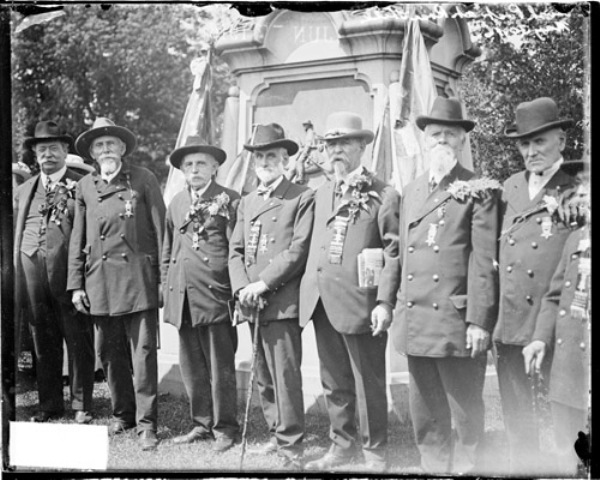Chicago History Museum Tumblr Page Looks At Black Civil War Soldiers
By Chuck Sudo in Arts & Entertainment on Feb 26, 2013 7:35PM

Group portrait of eight Civil War veterans standing by a memorial at Rosehill Cemetery, May 30, 1916 (DN-0066351, Chicago Daily News negatives collection, Chicago History Museum. )
Here’s your afternoon time suck: Photos from the Chicago History Museum’s archives of African American Civil War soldiers in 1863. The photos are posted on the museum’s Tumblr page and give a trapped-in-amber look back at the contributions of black soldiers during the War Between the States.
According to Drew VandeCreek, PhD., it’s a bit of a surprise Illinois was able to have African American Civil War soldiers.
”Illinois had never been a hospitable environment for African-Americans. The French had brought slavery to the Illinois Country, and the first Illinois legislature had obliged all African Americans settling in the state to produce a certificate of freedom. Blacks found without proper papers were advertised in newspapers and hired out as laborers. African Americans could not testify against whites in court.”
The Fugitive Slave Law of 1850 only made Illinois more inhospitable to blacks. Illinois’ black population at the start of the Civil War was 7,628, one-tenth of the population at the time.
Here’s more from VandeCreek:
”Changes in federal policy began to clear the way for black participation in the struggle. President Lincoln, intent upon a war for Union alone, had originally instructed officers to return slaves to their owners. But the Confiscation Act of March, 1862 prohibited these returns. As freed slaves began to enter Union lines as “contraband,” northern officers and politicians began to discuss their ability to work in support of Union forces, digging trenches, driving horses, and cooking meals. By July of 1862 Congress had authorized the president “to receive into the service of the United States, for the purpose of constructing intrenchments, or performing camp duty, or any other labor… The law provided that African American laborers be paid ten dollars a month, three dollars of which might pay for clothing, as compared to a white private’s monthly wage of thirteen dollars, plus a clothing allowance of three dollars and fifty cents. ”
The Emancipation Proclamation finally allowed blacks to serve as soldiers, but their white counterparts were still skeptical.
”Many whites feared that arming black soldiers threatened the nation’s system of white supremacy. While army labor did not diverge significantly from blacks’ usual roles as laborers and servants, military service elevated blacks in two important ways. First, many whites simply feared that armed African Americans might turn upon the whites that had treated them so poorly. This anxiety remained a fixture in the slaveholding South, particularly in regions in which slave populations greatly outnumbered white. But northern whites also flinched at the prospect of arming black men.”
The more things change, the more they stay the same, eh?